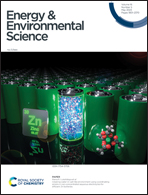Reduced 0.418 V VOC-deficit of 1.73 eV wide-bandgap perovskite solar cells assisted by dual chlorides for efficient all-perovskite tandems†
Abstract
Wide-bandgap (wide-Eg) perovskites with bandgaps over 1.65 eV have great potential for constructing tandem solar cells (TSCs); however, they still suffer from large open-circuit voltage (VOC) deficits. Phase segregation and non-radiative recombination are great challenges for inverted wide-Eg perovskite solar cells (PSCs) to achieve an ideal VOC and long-term operation stability. Herein, we report a synergistic strategy of using lead chloride (PbCl2) and phenethylammonium chloride (PMACl) to introduce chlorine (Cl) into a bulk film and form a two-dimensional (2D) phase at the film surface for 1.73 eV wide-Eg PSCs, which reduce the VOC-deficit from 0.558 V to 0.418 V. Cl in PbCl2 enters the crystal lattice of the perovskite film, reducing the halide vacancies and suppressing ion migration. Meanwhile, PMACl facilitates the formation of a 2D perovskite phase at the grain surfaces, alleviating recombination and improving the stability. As a result, the best-performing wide-Eg PSC with a high VOC of 1.312 V and an efficiency of over 20% is achieved, enabling the fabrication of two-terminal all-perovskite TSCs with a champion efficiency of 26.68%. This work provides in-depth insights into how Cl suppresses phase segregation and non-radiative recombination in wide-Eg PSCs, offering a promising strategy for efficient and stable all-perovskite TSCs.



 Please wait while we load your content...
Please wait while we load your content...